 advertisements advertisements
|

|
Jim McDivitt, astronaut who led Gemini 4 and Apollo 9, dies at 93
October 17, 2022 — Former NASA astronaut James McDivitt, who commanded the first U.S. mission to conduct a spacewalk before leading the first test flight of the Apollo moon lander in Earth orbit, has died at the age of 93.
NASA's history office noted McDivitt's death on Friday (Oct. 14) in a post to its social media channels.
"With heavy hearts, we mourn the recent passing of Korean War veteran, former test pilot, aeronautical engineer and NASA astronaut Jim McDivitt," the statement read. "Rest in peace."
McDivitt joined NASA in 1962 as a member of its second group of astronauts. Dubbed "The Next Nine" because they followed the "Original Seven" chosen in 1959, McDivitt's fellow classmates included Neil Armstrong, Jim Lovell and Ed White. McDivitt and White knew each other from college, had attended test pilot school together and were soon to be named as the crew of Gemini 4.
Today known for being the first American mission to perform an extravehicular activity (EVA, or spacewalk), the plan for Gemini 4 did not begin with an outing.
Up and out
"The flight was originally set up to be pretty much a medical experiment — a long-duration flight," McDivitt said during a 1999 NASA oral history interview. "We'd never had a flight longer than [34] hours and there weren't any Russian flights up till that time that were very long either, so, there was a lot of medical experimentation on it — tests and other assorted junk. And then a few scientific experiments. But mostly it was the four days, whether we were going to make it or not."
As talk of including a spacewalk picked up, the idea at first was that White would open his hatch and stick his head out as McDivitt held him down. Then on March 18, 1965, Soviet cosmonaut Alexei Leonov exited his Voskhod 2 spacecraft and floated outside for 12 minutes and 9 seconds, claiming the title as the world's first spacewalker.
Trailing again in the space race with the Soviets, NASA formally added a full EVA to Gemini 4. That decision required that some changes be made, including one to account for McDivitt's stature.
"I'm out of a very tall sitting height, 99 percentile or something. So, when we all of a sudden had to close the hatch in a pressurized condition, we had to redesign the seats," he said.
On June 3, 1965, McDivitt and White launched atop a Titan II rocket on what was the second crewed flight of NASA's Gemini program. Before sending White out on the first U.S. spacewalk, McDivitt attempted to achieve the world's first rendezvous in orbit, a feat that was ultimately unsuccessful.
The plan was for McDivitt to fly up next to the spent upper stage of the Titan, but several factors worked against him, including a lack of depth perception making it difficult for he and White to establish how far away they were from their target. That issue was considered minor, though, compared to the fact that the stage was not staying still.
"They left a vent open on it to vent the propellant on it, which acted like a small rocket engine. And when we backed away from it and did our inertial measurement unit alignment, the rocket started maneuvering away from us. So, I had to curtail the alignment to get back down close to the rocket," said McDivitt. "And then as we went into the dark, it continued to maneuver around. And it didn't have any stabilization anymore, so it could be going this way at one time and this way some other way some other time."
McDivitt estimated that the closest he was able to get to the stage was 200 feet (61 m), but White thought they were further away, between 850 and 1,000 feet (260 and 300 m). Needing to save propellant for the EVA, McDivitt gave up on the rendezvous and pressed on with the mission.
White's 23-minute EVA was more of a success, despite running into problems getting White's hatch opened at the start and then latching it at the end. McDivitt's photographs of White floating at the end of an umbilical while set against the blue and white of Earth below almost instantly became iconic. Further, White's EVA set the stage for a series of spacewalks to follow on later missions.
"It probably wasn't until after the flight that we really began to appreciate the fact that working outside a spacecraft was a lot different than working inside the spacecraft," said McDivitt. "And that again was a part of the experience that you had to gain to be able to do the Apollo stuff. No EVA experience going into Apollo would have been a serious problem."
A failed computer and a stuck thruster made for a rougher than expected landing, but McDivitt and White splashed down safely in the North Atlantic Ocean on June 7, 1965, four days and one hour after they launched.
Making ready for the moon
Like his first flight, McDivitt's second command did not proceed as first planned. This time, though, it was not the mission objectives that changed, but the order in which it was to fly.
In the wake of the Apollo 1 fire that claimed the lives of three astronauts including McDivitt's Gemini 4 crewmate White, McDivitt was assigned to the second crewed flight of the Apollo program. Apollo 8 would see McDivitt, David Scott and Rusty Schweickart test the Apollo lunar module in Earth orbit.
There was a problem, though. Grumman Aircraft (today, Northrop Grumman), NASA's primary contractor for the lunar module, was encountering delays building the moon lander. With the goal of landing a crew on the moon before the end of the decade and with the Soviets working towards the same goal, NASA adopted a new plan: it would send astronauts aboard a command module — without a lunar module — to the moon as the new second crewed mission of the Apollo program.
That meant that either McDivitt's crew would fly to the moon, setting aside all of the experience they had gained already working and training on the lunar module, or move from Apollo 8 to Apollo 9.
"Deke [Slayton, director of flight crew operations] explained the situation and said that he wanted me to stick with my original mission — which would now become Apollo 9. But he wasn't going to force me," McDivitt told co-author Michael Cassutt for "Deke! U.S. Manned Space From Mercury to the Shuttle," Slayton's 1994 autobiography. "I think it was that Rusty and I knew more about this particular lunar module than anyone else. So there was a certain logic to keeping us where we were."
"Over the years this story has grown to the point where people think I was offered the flight around the moon but turned it down," said McDivitt. "Not quite. I believe that if I'd thrown myself on the floor and begged to fly the [Apollo 8] mission, Deke would have let us have it. But it was never really offered."
So McDivitt, Scott and Schweickart launched as the Apollo 9 crew on March 3, 1969, lifting off atop a Saturn V rocket on board the command module "Gumdrop" with the lunar module "Spider" in tow. During the 10-day mission, the three tested equipment and skills that were needed to later land on the moon. They performed the first docking and extraction of a lunar module, the second docking of two crewed spacecraft and conducted a two-person spacewalk.
"The main thing was that we got a chance to fly the lunar module to see if it really worked," McDivitt said in his NASA oral history. "The fact that the rendezvous worked okay, the computers worked, the radar worked — [we] did a damn good job of engineering it, because we really didn't have very many big problems with the spacecraft. It all went together well."
"We had to make sure that it went together well and that it would work, because it was really a flimsy little spacecraft," he added.
As part of the mission, McDivitt became one of the first astronauts to move between spacecraft while in orbit and the first to fly the lunar module in space. He and his crewmates safely splashed down on Gumdrop in the North Atlantic Ocean on March 13, 1969. NASA declared the flight a complete success, paving the way for Apollo 10 to conduct a full-up dress rehearsal in lunar orbit for the first moon landing later that same year.
Apollo 9 was McDivitt's last flight into space. Over the course of his two missions, he logged a total of 14 days, 2 hours and 56 minutes off the planet, completing 217 orbits of Earth.
Moon mission manager
James Alton McDivitt was born on June 10, 1929 in Chicago, Illinois, though he grew up in grew up in Kalamazoo, Michigan and was educated in the state. He completed two years at Jackson Junior College (now known as Jackson College) in 1950 and later received his Bachelor of Science degree in aeronautical engineering from the University of Michigan, where he graduated first in his class in 1959.
Instead of waiting to be drafted by the U.S. Army for service during the Korean War, McDivitt enlisted in the U.S. Air Force in 1951 and received his pilot wings a year later. He flew 145 combat missions in Korea, piloting F-80 Shooting Star and F-86 Sabre jet fighters with the 35th Fighter-Bomber Squadron.
McDivitt returned to the U.S. in 1953, where he continued to serve as a pilot with the 19th Fighter Interceptor Squadron at Dow Air Force Base in Maine, at McGuire Air Force Base in New Jersey and with the 332d Fighter Interceptor Squadron.
After graduating from the University of Michigan, McDivitt reported to Edwards Air Force Base in California to become a test pilot. He stayed there with the Flight Test Center as an experimental flight test pilot and completed the Experimental Flight Test Pilot School and Aerospace Research Pilot School, before joining the Manned Spacecraft Operations Branch in July 1962.
On July 17, 1962, McDivitt flew as chase pilot for Robert White's X-15 rocket plane flight, which reached an altitude of 59.5 miles (95.8 km). White (no relation to McDivitt's Gemini 4 crewmate) became the first X-15 pilot to be awarded astronaut wings based on the Air Force definition of space starting at 50 miles (80 km).
McDivitt might have next flown the X-15, but instead decided to apply for NASA's astronaut corps.
After he joined the space agency, McDivitt was assigned to work on the guidance and navigation systems for Gemini. After his flight on Gemini 4, he served as a capcom (capsule communicator) in mission control for Gemini 5 and then became the Astronaut Office's engineering lead for the Apollo program.
Prior to his Apollo 8/9 assignment, McDivitt served as backup commander for the ill-fated AS-204 (Apollo 1) mission. After landing from Apollo 9, McDivitt decided to move into management.
"It was apparent to me that I wasn't going to be the first guy to land on the moon, which was important to me," he said. "Being the second or third guy wasn't that important to me."
Turning down other opportunities to head up the Air Force's Manned Orbiting Laboratory (MOL) program, serve as secretary of the Space Council or fly on Apollo 13, McDivitt became the manager of lunar landing operations and then manager of the Apollo spacecraft program, taking responsibility for the Apollo 12 through Apollo 16 missions.
"My first effort as a program manager was Apollo 12, when we launched it and then it got struck by lightning twice. Then I had to decide whether it was okay to send it to the moon or not. And I did," said McDivitt. "Then 13 was — it was probably the greatest spaceflight anybody has ever flown. And that worked out fine. Then, I think it was 14, we had solder balls flying around and sending 'I'm going to shut off'-engine shut off signals to the engine. And in 15 we had a major problem. I don't remember what [that was]. 16 we had the gimbal thing. And we were able to go forward with all of those except 13."
McDivitt resigned his position after hearing that Gene Cernan had been assigned to command Apollo 17. Cernan had recently crashed a helicopter, which McDivitt felt was a significant concern. His objection, though, was overruled, so McDivitt left once the Apollo 16 mission was over.
McDivitt retired from the U.S. Air Force with the rank of brigadier general in June 1972, the same month that he left NASA to take the position of executive vice president for corporate affairs at Consumers Power Company, a utility company in Michigan. In March 1975, he joined the rail transport company Pullman, Inc. as executive vice president and a director. Seven months later, he became president of the Pullman Standard Division.
In 1981, McDivitt went to work for Rockwell International (today part of Boeing), where he was senior vice president for Government Operations and International in Washington, D.C. He retired in 1995.
McDivitt was a member of the Society of Experimental Test Pilots (SETP) and the American Institute of Aeronautics and Astronautics (AIAA). He was also a Knight of Columbus, and represented the Order at the Third World Congress for the Lay Apostolate at the Vatican in 1967.
In 1974, McDivitt appeared as himself in the "Brady Bunch" episode "Out of This World." In 1998, he was portrayed by actor Conor O'Farrell in the HBO miniseries "From the Earth to the Moon."
In 2014, McDivitt contributed a chapter ("Career Limiting Capers") to "The Friday Pilots," edited and published by Don Shepperd.
For his service to the Air Force and space program McDivitt was honored with four Distinguished Flying Crosses, two Air Force Distinguished Service Medals, two NASA Distinguished Service Medals and the NASA Exceptional Service Medal, among other distinctions. In 1969, he was presented the Iven C. Kincheloe Award by the SETP. In 2006, NASA presented McDivitt the Ambassador of Exploration Award, a moon rock-embedded trophy, which he chose the University of Michigan College of Engineering in Ann Arbor to display.
McDivitt was enshrined in the International Space Hall of Fame in 1982, U.S. Astronaut Hall of Fame in 1993, International Air and Space Hall of Fame in 2012 and National Aviation Hall of Fame in 2014. He received honorary doctorate degrees from the University of Michigan in 1965, Seton Hall University in 1969, Miami University in 1970 and Eastern Michigan University in 1975.
An elementary school in Old Bridge, New Jersey is named in McDivitt's honor, as is a hall at Jackson College in Michigan. McDivitt-White Plaza is located outside West Hall at the University of Michigan.
McDivitt was married twice, first in 1956 to Patricia Ann Haas with whom he had four children (Michael, Ann Lynn, Patrick, and Kathleen) and then in 1985 to Judith Ann Odell with whom he gained two stepchildren. |
|
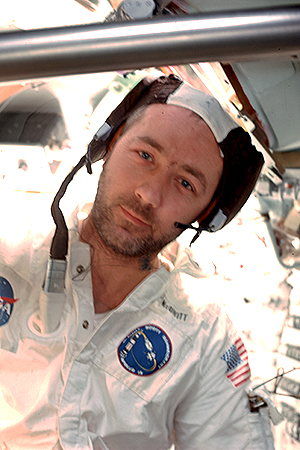
Apollo 9 commander Jim McDivitt, as seen on board the command module "Gumdrop" in March 1969. (NASA)
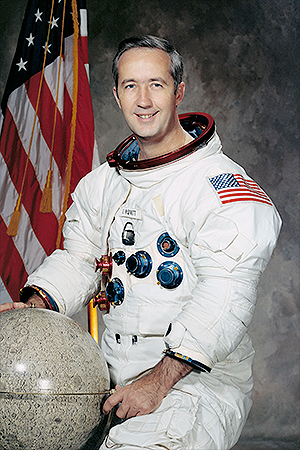
Official NASA portrait of Apollo 9 commander Jim McDivitt. (NASA)
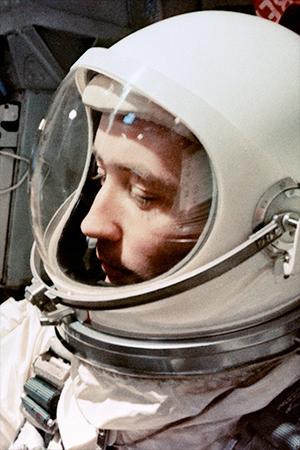
Jim McDivitt, seated to the right of Ed White, awaits their launch on board the Gemini 4 spacecraft on June 3, 1965. (NASA)
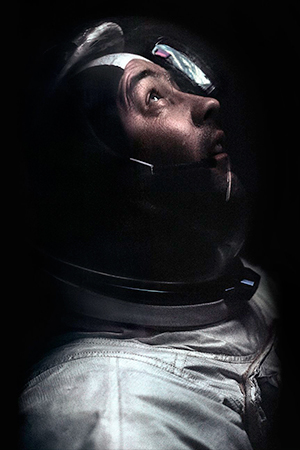
Apollo 9 commander Jim McDivitt looks out the window as he flies the lunar module "Spider" to a docking with the command module "Gumdrop." (NASA / Andy Saunders/ApolloRemastered.com)
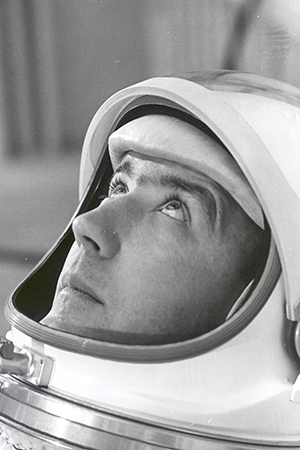
Jim McDivitt is suited in preparation for weight and balance training tests ahead of the Gemini 4 mission. (NASA)
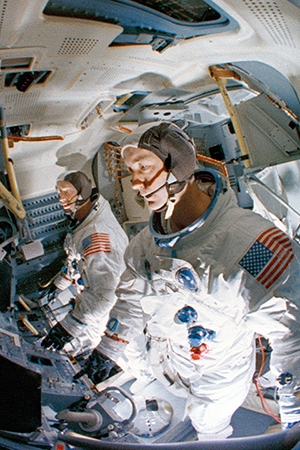
Fish-eye camera lens view of Apollo 9 commander Jim McDivitt (in the foreground) and Rusty Schweickart in the the Apollo Lunar Module Mission Simulator at the Kennedy Space Center. (NASA)
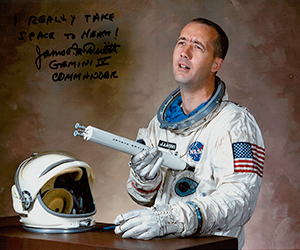
"I really take space to heart!" Gag photo of Jim McDivitt, Gemini 4 commander. (Heritage Auctions)
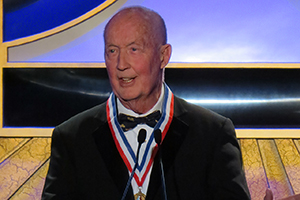
Jim McDivitt at his induction into the National Aviation Hall of Fame in Dayton, Ohio in 2014. (Mark Usciak/collectSPACE) |
|

© collectSPACE. All rights reserved.
|
|

|

|
